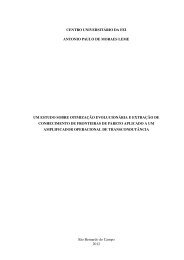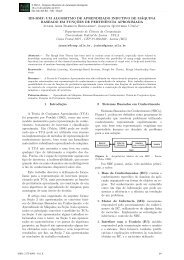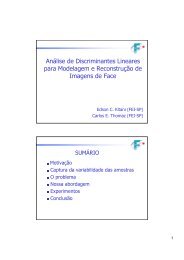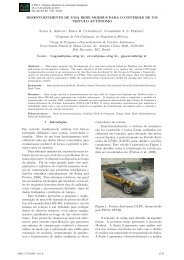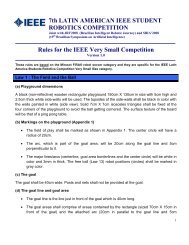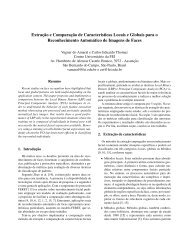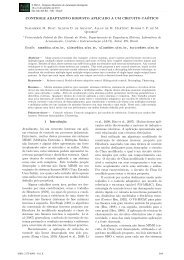ANALOG INTEGRATED CIRCUITS DESIGN BY MEANS OF GENETIC ALGORITHMS ...
ANALOG INTEGRATED CIRCUITS DESIGN BY MEANS OF GENETIC ALGORITHMS ...
ANALOG INTEGRATED CIRCUITS DESIGN BY MEANS OF GENETIC ALGORITHMS ...
Create successful ePaper yourself
Turn your PDF publications into a flip-book with our unique Google optimized e-Paper software.
solutions (close to A V0 des), tend to an evaluation value of 100<br />
and worse solutions tend to an evaluation value of 0.<br />
GA processing flowchart is shown in Fig. 5. First, GA<br />
generates an initial population with random values of W, L and<br />
g m/I DS, this is the “Random generated population” shown in the<br />
flowchart. Once a population was created, each individual is<br />
evaluated, according to the open-loop voltage gain obtained,<br />
following the process of evaluation described earlier in this<br />
section. The best-evaluated individual is saved in memory to be<br />
used after in the elitism process. Elitism is a process that<br />
introduces in the next generation the best-evaluated individual<br />
of the current generation. The Elitism is important to ensure that<br />
the best-evaluated individual in the next generation will be<br />
better or at least equal in evaluation than the best-evaluated<br />
individual of the past generation. Thus, it ensures that always<br />
next generations will have better or at least equal solutions in<br />
evaluation than past ones.<br />
Next in the flowchart, there is the selection process. This<br />
process will select pairs of individuals that will be used for the<br />
reproduction process. Individuals are selected using the roulette<br />
method. In roulette method, solutions with better evaluations<br />
have more chance to be chosen for reproduction. The designer<br />
sets the occurrence of reproduction as desired in percentage.<br />
Reproduction is performed with individuals defined in<br />
selection process. These individuals have its W and L modified<br />
using binary one-point crossover and g m/I DS is modified using<br />
mean crossover operation as explained earlier in this section.<br />
Mutation will cause minor changes in some individuals. For W<br />
and L, this change is performed flipping one of the 11 bits of its<br />
data and for g m/I DS the mutation is performed adding a random<br />
value to it. The designer sets the incidence of mutation as<br />
desired in percentage unit.<br />
After selection, reproduction, mutation and elitism, a new<br />
generation is created. GA (evaluation, selection, mutation and<br />
elitism) will process this new generation only if the total<br />
number of individuals generated is not reached. The total<br />
number of individuals is the total of individuals generated so<br />
far, considering that each generation creates 100 new<br />
individuals. For this work, we are using a total of 8000<br />
individuals generated and 100 individuals per generation, what<br />
means that GA run 80 times or 80 generations will occur to<br />
reach the end of GA evolution processing.<br />
At the end of these 80 generations, the best solution<br />
encountered so far is presented as one solution and one round is<br />
finished. A new round means to start a new random-generated<br />
population and begin the process of evolution again. At the end<br />
of this new round, a new solution encountered is presented. The<br />
designer chooses the number of rounds and, as bigger is the<br />
number of rounds set; more possible solutions are presented at<br />
the end of process. We are using a number of 20 rounds for this<br />
work, what means that 20 possible solutions are presented at the<br />
end of the process, taking into account the open-loop voltage<br />
gain.<br />
As reference, the unit voltage gain frequency (f T) also is<br />
presented. The unit voltage gain frequency doesn’t have any<br />
influence in evaluation process or GA processing.<br />
4. EXPERIMENTAL RESULTS<br />
The GA tests are performed using the following<br />
information: W search range: 1 to 1000 μm; L range 3 to 12<br />
µm; differential pair (M1 and M2) g m/I DS range 0 to 10 V -1 ;<br />
objective open-loop voltage gain equal to 34 dB or 56. Using<br />
these parameters, it was possible to obtain W and L results<br />
suitable to achieve about 99.9% (average of 20 rounds) of the<br />
objective open-loop voltage gain for about 10 generations (total<br />
Random generated<br />
population<br />
Evaluation of individuals<br />
based in A V0 obtained<br />
Individual with best<br />
evaluation kept for next<br />
generation (for Elitism)<br />
Selection of individuals for<br />
reproduction based on<br />
roulette method<br />
Reproduction: binary for<br />
W,L and mean for g m/I DS 1<br />
Mutation<br />
Elitism: best-evaluated<br />
individual prepared to be<br />
introduced in next generation<br />
Total<br />
number of individuals<br />
reached?<br />
Y<br />
Best individual stored as the<br />
best solution for this round<br />
Total<br />
number of rounds<br />
reached?<br />
Y<br />
Best solutions found for<br />
each round presented as<br />
solutions found by GA<br />
Next<br />
generation<br />
individuals generated equals to 1000), as shown in Figures 5<br />
and 6.<br />
Analyzing Figures 5 and 6, we can see a fast convergence of<br />
the evaluation obtained by the best individuals of each<br />
generation on average for 20 GA rounds. As closer as the result<br />
obtained reaches the value of 100, closer to the desired openloop<br />
voltage gain, that is 56, is the open-loop voltage obtained<br />
by the best individual in a generation.<br />
N<br />
N<br />
Fig. 5 GA processing flowchart.<br />
Next<br />
round<br />
END



